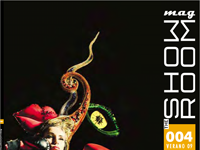
By Ramiro Carrillo
What you can see in these photographs are oil paintings, pencil drawings and sculptures cut from a single piece of stone or wood by the hand of Rómulo Celdrán, an extraordinary artist who bases his work on a disconcerting supposition: reality does not exist.
What you can see in these photographs are oil paintings, pencil drawings and sculptures cut from a single piece of stone or wood by the hand of Rómulo Celdrán, an extraordinary artist who bases his work on a disconcerting supposition: reality does not exist.
The first reaction that people experience on seeing this artist’s work is often disbelief. It is hard to believe that the photograph in front of us is not truly a photograph, but a drawing done with the same kind of pencil we would use to note down our shopping list or to solve a crossword. The prodigious skill that this artist exhibits in drawing and his remarkable precision, alongside his aptness in choice of subject, turn his work not only into incredible technical exercises, but also into enormously interesting works of art.
Born in Gran Canaria and having made Murcia his home, Rómulo Celdrán initially studied to become a social worker, but eventually abandoned his studies as his love of painting demanded ever more dedication. As fate would have it, he is now once again in Gran Canaria’s Las Palmas, in time for his exhibition at the Manuel Ojeda gallery, which has given us first-hand access to his drawings, paintings and sculptures which never fail to perplex.
However, it is not his remarkable technical virtuosity that lends this artist’s work its value. Of course, the radical realism of his work is what keeps the spectator lost between what his eyes see (for example, a stone block crushing a cardboard box) and what he knows he is seeing (a polychrome sculpture cut from a single stone block). Now, if it were merely that, his work would be nothing more an exercise in showboating, with a certain merit but empty of content, as is the case for many other artists who tend to refer to themselves as “realists”. But in the case of this artist, the to-and-fro of what our eyes see and what our reason tells us is deeply disconcerting. Strangely, it manages to plant a seed of doubt regarding what we may or may not consider to be real. The artist says so himself: “Reality does not exist. What we understand as real is the physical and chemical mental process that allows us to perceive the outside world. We decode light vibration and call the result reality.”
And it’s true: what we see is nothing more than the way in which the brain interprets information sent from sensory organs, hence the vast difference in the way in which certain people see the world and others, and hence the way in which sufficiently skilled artists like Rómulo Celdrán are able to fool our perception, making us see things that are not there, like the ancient myth of the Greek artist who painted grapes so faithfully that birds would come to peck at them, thinking they were real.
Nonetheless, in our daily lives, we usually act as though reality were an objective truth. In the visual arts, for example, many people still believe that there exists an “objective” beauty, or that a painting that is photographic in appearance is more real, and hence truer, than an abstract work. Rómulo Celdrán sets himself the task of questioning both. Let’s consider his subject matter for a moment. He does not paint “artistic” subjects, things that are somehow special and “worthy of being painted,” so to speak, rather he depicts building blocks or old wheels, the interior of a toolshed, clothes hung out to dry or a pair of old pliers on a table. No one could say that these themes have much to tell us; here it is not a question of wondering “what do these paintings mean?” because, in the same way that applies to abstract painting, these paintings do not mean anything. By painting trivial subjects, Celdrán shows that their aesthetic interest does not depend on our usual criteria of “beauty”: in his hands, something which is objectively dirty or simply junk is transformed into a magnificent painting. And the curious – and interesting – thing about his work is that, despite its surprising photographic appearance, in order to appreciate this painting, one has to treat it as an abstract work, because what the artist has painted are, essentially, textures: both the formal textures of the objects chosen and that other texture that forms the epidermis of his work, the weft of their phenomenal visual literalness.
For these reasons, it is worth your while to take a stroll through the gallery, either in person or virtually, to see the pieces for yourself. Though I warn you now: however close you get to these works, you will never fully resolve your doubts as to whether they are drawings or photographs. They are so well done that it is hard to know what to believe. But this is a quality of great artists: their task is to bring doubts and questions into our minds. The decision as to whether their suppositions are true or false – or both at the same time – comes down to our own personal choice.